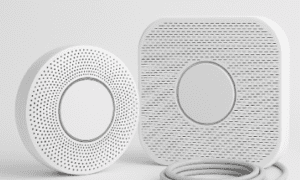Once upon a time, a restaurant chair was just that, a seat to rest on while enjoying a meal. But today, chairs are becoming just as smart as phones and thermostats. In a world where technology continues to shape everything from the way we order food to how quickly it arrives, it was only a matter of time before it reached the very seat beneath us.
Smart seating is no longer a futuristic idea. It’s here, quietly revolutionizing how diners experience hospitality. Guests want more than just food, they crave comfort, personalization, and memorable touches. That’s where IoT-enabled chairs come in. These advanced furnishings do more than just support your back. They gather data, respond to body movements, and help restaurants operate more smoothly.
Restaurants looking to stand out in a crowded market are turning to intelligent furniture to create the kind of experiences people remember and talk about. With every passing year, expectations rise. Diners now anticipate convenience, personalization, and a touch of innovation with every visit. Smart restaurant furniture, such as seating, answers that call and does so without losing the warmth and hospitality we all enjoy.
Smart Chairs 101: What Makes a Chair ‘IoT-Enabled’?
Smart chairs are no ordinary seats. These are embedded with sensors and wireless connectivity that let them collect and share information in real time. Think of them as silent assistants, quietly watching, recording, and improving every guest’s visit. Features like occupancy detection, temperature tracking, and even weight sensing allow restaurants to better understand how guests are using their space. These chairs don’t just sit around, they communicate with restaurant systems to time service, monitor usage, and help predict needs.
Bluetooth and Wi-Fi are the lifelines that keep these chairs connected to the wider network. Their ability to integrate seamlessly with other smart restaurant tools is what makes them truly valuable. Hospitality design is evolving, and patents for IoT seating solutions are growing steadily. Hotels, lounges, and even airports are piloting smart seating systems, signaling how quickly the trend is catching on.
Behind the scenes, cloud platforms analyze every bit of data coming from these chairs. They don’t just collect information; they learn from it and help restaurants fine-tune the way they welcome guests.
Enhancing Guest Comfort in Real Time
One of the biggest advantages of IoT chairs is how well they respond to guests’ needs. Instead of waiting for someone to complain about a stiff back or an uncomfortable seat, smart chairs adjust automatically based on posture or body position. They also send subtle signals to alert servers when someone might be ready to order or needs attention, improving speed and reducing wait times. In more luxurious settings, these chairs can even manage temperature through specialized upholstery and communicate via gentle lights or vibrations.
Frequent diners benefit from features that store individual seat preferences. Whether it’s firmness, tilt, or temperature, returning guests are welcomed with comfort tailored to their liking. And with connected apps or on-seat touch panels, anyone can fine-tune their seating on the spot.
Long meals or business lunches often leave people squirming by the end. Smart seating responds to subtle movements to reduce strain and support the body gently throughout the visit.
Boosting Operational Efficiency with Smart Seating
Beyond guest satisfaction, smart chairs help restaurants run smarter. By tracking seat usage, they allow hosts to see exactly which tables are open or occupied, improving accuracy during busy hours. Patterns in seat traffic highlight which areas are underused, helping owners rethink layout and flow. Smart chairs can also spot early signs of wear, sending alerts when something needs fixing before it breaks or affects a guest.
Servers benefit too. Rather than guessing who needs help, they’re guided by data, reducing missed orders and forgotten requests. Restaurants using smart seating have trimmed their average table turnover time by 18 percent, an impressive gain, especially in fast-paced settings.
Scheduling becomes more precise when managers know exactly when seats are busiest. And with smart chairs alerting cleaning staff when a guest leaves, cleanliness stays top-notch without the need for constant manual checks.
Data Insights That Drive Better Design
What if your chairs told you what kind of furniture your guests want? That’s what smart seating allows. By measuring how long guests sit, how often they shift, and even which temperature they prefer, designers can build more thoughtful, comfortable spaces. Seasonal trends and guest demographics come to life through this data, allowing layout changes that match needs as they change throughout the year.
Seating feedback also influences how fast courses are served, letting kitchens coordinate better with what’s happening at the table. As energy costs climb, the data from smart chairs even helps regulate heating and cooling based on real usage. Restaurants that have embraced this technology have seen a 12 percent increase in repeat visits. Comfort does bring people back.
Heatmaps reveal seating hot spots and ghost zones, enabling smarter planning. As time goes on, data-driven tweaks in shape, cushion design, and material choices lead to better support and happier guests.
Accessibility and Inclusivity Benefits
Smart seating isn’t just about comfort or convenience. It’s also a big step toward making restaurants more inclusive. These chairs can adjust automatically for guests with mobility issues, raising or lowering to ease movement and support. For young diners, sensors can identify when a child needs a booster or a different kind of ergonomic support.
For guests with health conditions or limited mobility, real-time alerts ensure timely assistance without needing to call out. Chairs equipped with multilingual instructions or audio prompts make life easier for tourists and those who are visually impaired. Accessibility tools like these help create spaces where everyone feels welcome.
Seniors benefit from stability-focused seating and gentle tilt support. Restaurants offering these features are earning more favorable reviews, particularly from those who appreciate thoughtful accessibility.
Challenges to Adoption and How to Overcome Them
Every new technology comes with hurdles. The initial investment in smart seating can seem steep, but it quickly pays for itself with gains in efficiency, service, and customer loyalty. Privacy is another concern, but strong encryption and transparent data practices ease worries.
Staff training might feel overwhelming at first, yet intuitive interfaces and minimal button-pushing make learning simple. Many restaurant owners worry about replacing all their furniture, but retrofitting is an option. Existing chairs can be upgraded without a complete overhaul, making this shift more manageable.
Durability matters. Designers now build smart chairs tough enough for high-traffic environments without sacrificing comfort. And for restaurants that qualify, government programs may help cover early adoption costs. Balance is also essential. Too much automation can feel cold. Successful implementations pair smart tools with warm hospitality to maintain that personal touch guests love.
Looking Ahead: What the Future Holds for Smart Seating
The future of smart seating is filled with possibilities. We may soon see chairs that respond to voice commands or integrate with AR menus for an immersive experience. Biometric sensors may allow each chair to recognize individual guests, adjusting instantly to their preferences.
Movement and expression tracking could help staff better understand guest mood and needs without being intrusive. AI could work behind the scenes to create a perfect combination of lighting, temperature, and posture for every diner. The smart seating market is growing fast, projected to rise by over 14 percent each year through 2030.
Connected wearables may soon link to seats, allowing real-time health tracking while dining. And as eco-conscious design becomes a must, smart chairs will likely evolve with sustainable materials and energy-saving capabilities.
Closing Thoughts: Where Innovation Meets Hospitality
A simple chair can do more than hold you up. In the world of smart seating, it can listen, adapt, learn, and help. These high-tech chairs don’t replace good service. They strengthen it.
Comfort is no longer a bonus. It’s expected. And smart chairs help restaurants deliver it consistently, quietly working behind the scenes to make each guest feel just a bit more welcome. For restaurant owners, dipping into this innovation with a small pilot program could lead to big results.
Those who embrace it early are not just upgrading their furniture. They’re upgrading their entire guest experience. When a guest sits down and instantly feels at ease, the meal is already off to a good start. Smart seating is where thoughtful design, technology, and hospitality come together, and it’s changing the way we dine for the better.































